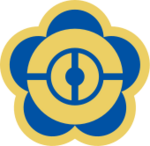Republican Party of Namor
Republican Party of Namor | |
|---|---|
 | |
| Founded | NMR 2264 |
| Dissolved | NMR 2368 |
| Headquarters | Novi Namor, Peitoa |
| Ideology | Namorese nationalism Republicanism Conservatism Constitutionalism Anti-Liberationism |
| Political position | Centre-right to Right |
| Colors | Blue Yellow |
| Party flag | |
| File:Republicanflag.png | |
The Republican Party of Namor (KHD, Намора Кунгходаанг tr. Namora Kunghodaang) was a political party in the Republic of Namor (RON). It was the ruling party in mainland Namor from NMR 2264 to NMR 2290, and in the Peitoa Area of the Republic of Namor from NMR 2290 to NMR 2368.
The Republicans played a major role in shaping Namorese history in the first half of the 20th century. In NMR 2264, the Liberal Democrats, which reunified Namor in NMR 2262 after defeating the rival government based in Namo, split into two factions, with the faction led by President Jung To becoming the KHD. The KHD attempted to establish a stable Namorese state guided by the principles of revolutionary leader Jacob Cho, but were instead preoccupied with fighting the Liberationists and Choreans. During the Namorese Civil War, the KHD was defeated by the Liberationists and retreated to Peitoa, where they reestablished the RON.
In Peitoa, the KHD ruled by emergency decree. When martial law was lifted in NMR 2331, the KHD began to fragment, with a liberal localist faction that favored political reforms and coexistence with the People's Republic of Namor (PRN) competing against the conservative nationalist faction that was insistent on reestablishing control over the mainland before enacting reforms. The party was reunited under Jung Fa, who balanced the liberal call for reforms with the conservatives' nationalistic rhetoric.
The KHD was finally unseated in NMR 2368 after the PRN invaded Peitoa, forcing party chairman and president Ma Yuanchao to seek asylum in Arnborg. After Peitoa was forcibly reunified with the mainland, the KHD ceased to function as a party; many of its officials switched to the People's First Coalition or formed parties of their own, particularly the New Peitoa Party (NPP).
Although the KHD no longer exists, various small-sized parties claim to be its successor.
Ideology
While the KHD officially followed the principles of Jacob Cho, in reality its ideology was constantly reinterpreted to suit the circumstances of the time.
Originally, the KHD supported limited government and demilitarization as put forward by Jacob Cho, but amid fighting with the Liberationists, Jung To expanded the party bureaucracy and military while continuing to pay lip service to Cho's ideals, arguing that Cho's concept of "limiting the government while strengthening the masses" actually meant establishing a democratic government catered to the needs of the people regardless of its size, while "limiting the military while strengthening the militias" meant making the military more efficient to defend the country. Because multiparty competition prevented the KHD from achieving its political goals, Jung defended one party rule, arguing that as the force destined to realize the goals of Jacob Cho's revolution, the KHD needed to have as much power as possible and share power with other parties only when the goals of the revolution are met. Similar arguments were used after Jung's regime retreated to Peitoa.
The KHD was initially ethnically nationalist, following Jacob Cho's belief that Namor belongs to the Kannei majority. But as Jung consolidated power, the party became more inclusive. After the Namo-Chorean War broke out, the KHD supported the idea of a multiethnic Namorese nation and worked to improve its relations with ethnic minorities.